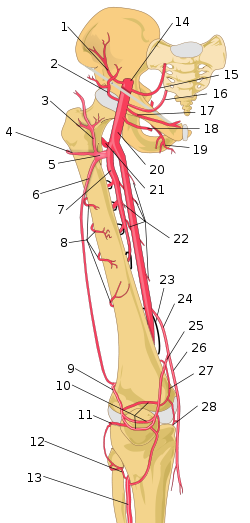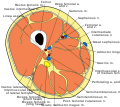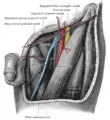Femoral artery
| Femoral artery | |
|---|---|
 Structures passing behind the inguinal ligament. (Femoral artery labeled at upper right.) | |
 Schema of femoral artery (labeled as #20) and its major branches - right thigh, anterior view. | |
| Details | |
| Source | external iliac artery |
| Branches | Superficial epigastric artery, Superficial iliac circumflex, Superficial external pudendal, Deep external pudendal, Deep femoral artery |
| Vein | femoral vein |
| Supplies | anterior compartment of thigh |
| Identifiers | |
| Latin | arteria femoralis |
| MeSH | D005263 |
| TA98 | A12.2.16.010 |
| TA2 | 4674 |
| FMA | 70248 |
| Anatomical terminology | |
The femoral artery (Template:Lang-la) is a large artery in the thigh. It begins at the inguinal ligament (femoral head). In this segment, it is also called the common femoral artery ([arteria femoralis communis] Error: {{Lang}}: text has italic markup (help)) and gives the deep femoral artery, which provides blood to the thigh. After the branching of the deep femoral artery, it is called the superficial femoral artery ([arteria femoralis superficialis] Error: {{Lang}}: text has italic markup (help)) in clinical parlance, because of its superficial course. It continues along the femur to provide blood to the arteries that circulate the knee and the foot and enters the adductor canal. After it emerges from the adductor canal through the adductor hiatus, it is named the popliteal artery.[1]
Anatomy
The femoral arteries receive blood through the external iliac artery. This connection occurs at the femoral triangle behind the inguinal ligament, which is usually near the head of the femur bone. That proximal section of the femoral artery, known specifically as the common femoral artery (CFA), leaves the femoral triangle through an apex beneath the sartorius muscle. It then divides into a deep femoral artery, more commonly known as the Profunda, which provides blood to the thigh, and the superficial femoral artery or SFA, which connects to the popliteal artery at the opening of adductor magnus or hunter's canal towards the end of the femur.
The branches of femoral arteries are (from proximal to distal) the superficial and deep external pudendal, superficial epigastric, superficial circumflex iliac, profunda femoral and descending genicular arteries.
Clinical significance
As the femoral artery can often be palpated through the skin, it is often used as a catheter access artery. From it, wires and catheters can be directed anywhere in the arterial system for intervention or diagnostics, including the heart, brain, kidneys, arms and legs. The direction of the needle in the femoral artery can be against blood flow (retro-grade), for intervention and diagnostic towards the heart and opposite leg, or with the flow (ante-grade or ipsi-lateral) for diagnostics and intervention on the same leg. Access in either the left or right femoral artery is possible and depends on the type of intervention or diagnostic.
The femoral artery is susceptible to peripheral arterial disease.[2] When it is blocked through atherosclerosis, percutaneous intervention with access from the opposite femoral may be needed. Endarterectomy, a surgical cut down and removal of the plaque of the femoral artery is also common.
The femoral artery can be used to draw arterial blood when the blood pressure is so low that the radial or brachial arteries cannot be located.
The site for optimally palpating the femoral pulse is in the inner thigh, at the mid-inguinal point, halfway between the pubic symphysis and anterior superior iliac spine. Presence of a femoral pulse has been estimated to indicate a systolic blood pressure of more than 50 mmHg, as given by the 50% percentile.[3]
References
- ^ Schünke, Michael; Schulte, Erik; M. Ross, Lawrence; D. Lamperti, Edward; Schumacher, Udo (2006). Thieme. p. 490. ISBN 9783131420817 http://books.google.si/books?id=NK9TgTaGt6UC&pg=PA490&lpg=PA490.
{{cite book}}: Missing or empty|title=(help); Unknown parameter|book=ignored (help) - ^ http://www3.interscience.wiley.com/journal/112187506/abstract?CRETRY=1&SRETRY=0
- ^ Deakin CD, Low JL (2000). "Accuracy of the advanced trauma life support guidelines for predicting systolic blood pressure using carotid, femoral, and radial pulses: observational study". BMJ. 321 (7262): 673–4. doi:10.1136/bmj.321.7262.673. PMC 27481. PMID 10987771.
{{cite journal}}: Unknown parameter|month=ignored (help)
Additional images
-
Structures surrounding right hip-joint.
-
Cross-section through the middle of the thigh.
-
Femoral sheath laid open to show its three compartments.
-
The left femoral triangle.
-
The femoral artery.
-
The spermatic cord in the inguinal canal.
-
Front of right thigh, showing surface markings for bones, femoral artery and femoral nerve.
-
Schema of arteries of the thigh.
-
Femoral artery and its major branches - right thigh, anterior view.
-
Femoral artery
-
Femoral artery
-
Femoral artery
External links
- Anatomy photo:12:05-0101 at the SUNY Downstate Medical Center
- Cross section image: pelvis/pelvis-e12-15—Plastination Laboratory at the Medical University of Vienna
- Image at umich.edu - pulse
- Diagram at MSU












